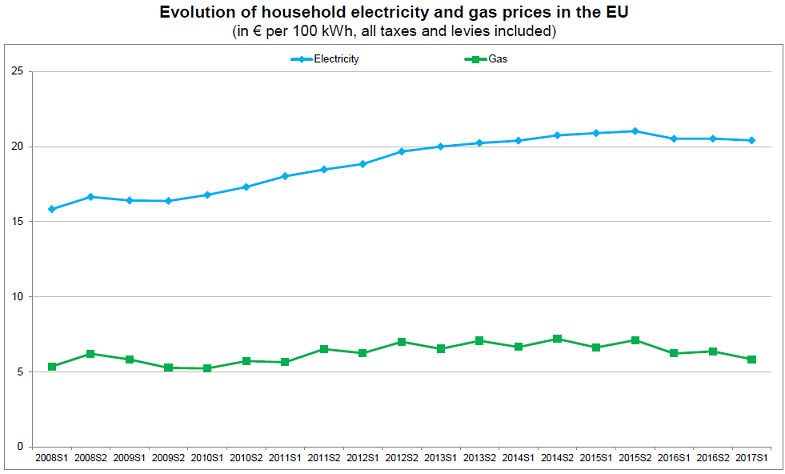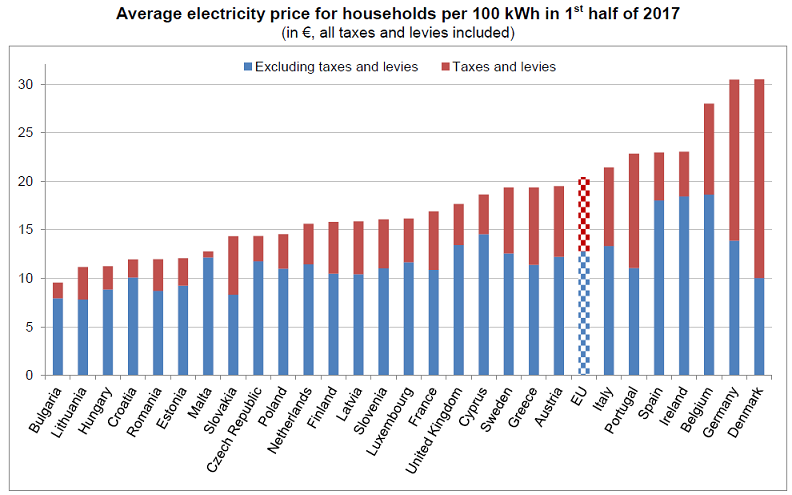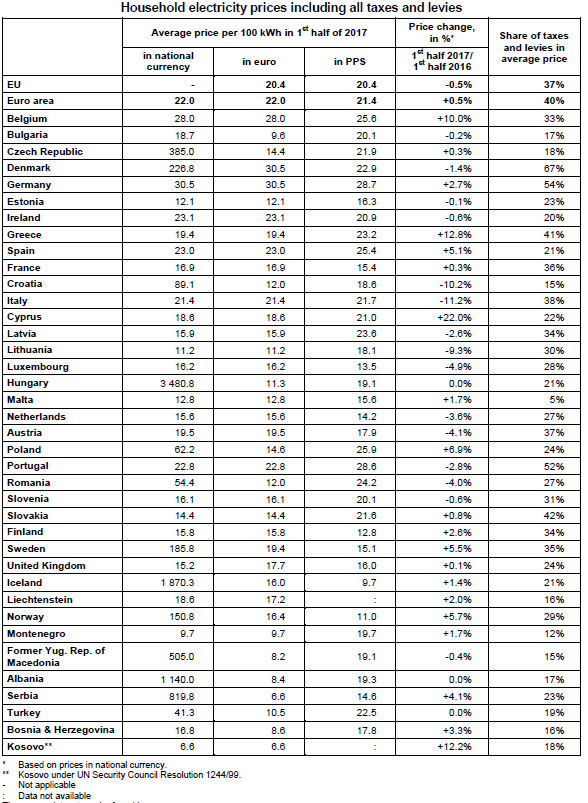
Back to article overview



Energy prices in 2017
Household energy prices in the EU down compared with 2016
-0.5% for electricity and -6.3% for gas
In the European Union (EU), household electricity prices slightly decreased (-0.5%) on average between the first half of 2016 and the first half of 2017 to stand at €20.4 per 100 kWh. Across the EU Member States, household electricity prices in the first half of 2017 ranged from below €10 per 100 kWh in Bulgaria to more than €30 per 100 kWh in Denmark and Germany.
Household gas prices fell by 6.3% on average in the EU between the first halves of 2016 and 2017 to stand at €5.8 per 100 kWh. Among Member States, household gas prices in the first half of 2017 ranged from less than €3.5 per 100 kWh in both Romania and Bulgaria to slightly above €8 per 100 kWh in Denmark and €12 per 100 kWh in Sweden.
Taxes and levies in the EU made up on average over a third (37%) of the electricity price charged to households in the first half of 2017, and about a quarter (26%) of the gas price.
These figures on energy prices in the EU are complemented with two articles and an interactive infographic published by Eurostat, the statistical office of the European Union.

Highest increases in electricity prices in Cyprus, Greece and Belgium, largest falls in Italy, Croatia and Lithuania
Across the EU Member States, the highest increase in household electricity prices in national currency between the first half of 2016 and the first half of 2017 was registered by far in Cyprus (+22.0%), followed by Greece (+12.8%), Belgium (+10.0%), Poland (+6.9%), Sweden (+5.5%) and Spain (+5.1%). In contrast, the most noticeable decreases were observed in Italy (-11.2%), Croatia (-10.2%) and Lithuania (-9.3%), well ahead of Luxembourg (-4.9%), Austria (-4.1%), Romania (-4.0%) and the Netherlands (-3.6%).
Expressed in euro, average household electricity prices in the first half of 2017 were lowest in Bulgaria (€9.6 per 100 kWh), Lithuania (€11.2) and Hungary (€11.3) and highest in Denmark and Germany (both €30.5) followed by Belgium (€28.0). The average electricity price in the EU was €20.4 per 100 kWh.

When expressed in purchasing power standards (PPS), an artificial common reference currency that eliminates general price level differences between countries, it can be seen that, relative to the cost of other goods and services, the lowest household electricity prices were found in Finland (12.8 PPS per 100 kWh), Luxembourg (13.5) and the Netherlands (14.2), and the highest in Germany (28.7), Portugal (28.6), Poland (25.9), Belgium (25.6) and Spain (25.4).
Half or more of the electricity price is made up of taxes and levies in Denmark, Germany and Portugal
The share of taxes and levies in total household electricity prices varied significantly between Member States, ranging from two-thirds in Denmark (67% of household electricity price is made up of taxes and levies) and over half in Germany (54%) and Portugal (52%) to 5% in Malta in the first half of 2017. On average in the EU, taxes and levies accounted for more than a third (37%) of household electricity prices.

The source dataset can be found here.
Geographical information
The European Union (EU) includes Belgium, Bulgaria, the Czech Republic, Denmark, Germany, Estonia, Ireland, Greece, Spain, France, Croatia, Italy, Cyprus, Latvia, Lithuania, Luxembourg, Hungary, Malta, the Netherlands, Austria, Poland, Portugal, Romania, Slovenia, Slovakia, Finland, Sweden and the United Kingdom.
The euro area includes Belgium, Germany, Estonia, Ireland, Greece, Spain, France, Italy, Cyprus, Latvia, Lithuania, Luxembourg, Malta, the Netherlands, Austria, Portugal, Slovenia, Slovakia and Finland.
The euro area includes Belgium, Germany, Estonia, Ireland, Greece, Spain, France, Italy, Cyprus, Latvia, Lithuania, Luxembourg, Malta, the Netherlands, Austria, Portugal, Slovenia, Slovakia and Finland.
Methods and definitions
Household energy price data are reported by National Statistical Institutes, Ministries, Energy Agencies or, in case of monopolies, by single companies.
The prices include basic price, transmission, system services, meter rental, distribution and other services. The prices are collected and published considering three levels of taxation: prices excluding taxes and levies; prices excluding VAT and other recoverable taxes; prices including all taxes, levies and VAT.
Electricity prices refer to prices for a household with an annual consumption of between 2 500 and 5 000 kWh, and include taxes. These prices are weighted by national household consumption to give the EU averages. The final price charged to electricity customers will depend on the structure of electricity tariffs and contracts which normally contain a number of factors, including fixed charges and unit prices that vary according to the amount of electricity and the time of day it is consumed.
Gas prices refer to prices for a household with an annual consumption of between 5 600 and 56 000 kWh of gas, and include taxes. These prices are weighted by national household consumption to give the EU averages. The final price charged to gas customers will depend on the structure of gas tariffs and contracts which normally contain a number of factors, including fixed charges and unit prices that vary according to the volume of gas consumed.
The prices include basic price, transmission, system services, meter rental, distribution and other services. The prices are collected and published considering three levels of taxation: prices excluding taxes and levies; prices excluding VAT and other recoverable taxes; prices including all taxes, levies and VAT.
Electricity prices refer to prices for a household with an annual consumption of between 2 500 and 5 000 kWh, and include taxes. These prices are weighted by national household consumption to give the EU averages. The final price charged to electricity customers will depend on the structure of electricity tariffs and contracts which normally contain a number of factors, including fixed charges and unit prices that vary according to the amount of electricity and the time of day it is consumed.
Gas prices refer to prices for a household with an annual consumption of between 5 600 and 56 000 kWh of gas, and include taxes. These prices are weighted by national household consumption to give the EU averages. The final price charged to gas customers will depend on the structure of gas tariffs and contracts which normally contain a number of factors, including fixed charges and unit prices that vary according to the volume of gas consumed.
For more information
Eurostat website section dedicated to energy statistics.
Eurostat database on energy.
Eurostat methodology on energy prices.
Eurostat Statistics Explained articles on electricity and natural gas price statistics.
Eurostat "Theme in the spotlight" website section highlighting some facts and figures about energy prices in the EU.
Eurostat website section dedicated to energy statistics.
Eurostat database on energy.
Eurostat methodology on energy prices.
Eurostat Statistics Explained articles on electricity and natural gas price statistics.
Eurostat "Theme in the spotlight" website section highlighting some facts and figures about energy prices in the EU.
Source: Eurostat

